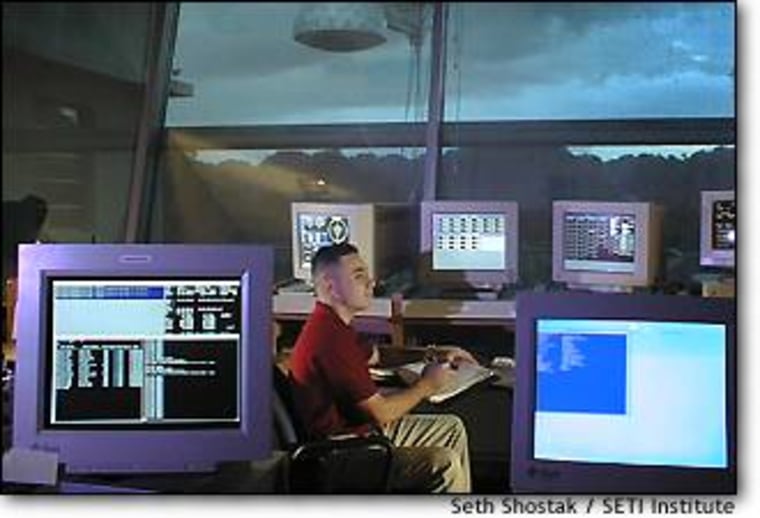Sometimes I wish hunting for aliens were as simple as it appears in the movies.
When Jodie Foster tried to eavesdrop on our far-out friends in “Contact,” she simply sat on the hood of her sports car and donned a pair of earphones. Charlie Sheen’s efforts in “The Arrival” were only slightly more complicated. He first co-opted local TV addicts by surreptitiously wiring their backyard satellite dishes to form an ersatz SETI telescope. After that, it was easy. Sheen sat back, drummed his fingers, and waited for alien signals to light up his oscilloscope.
The real picture’s not quite so pretty. Today’s SETI systems, which monitor tens of millions of channels simultaneously and have to contend with smothering terrestrial interference, are complicated, one-of-a-kind beasts. They’re always on the hairy edge, and every observing run is scarred by technical glitches.
This time, the scarring began early. We had just started our March observing session for Project Phoenix, happily aiming the Arecibo radio telescope at nearby stars. The extraterrestrials, as is their wont, had so far kept mum, but the experiment’s progress was as smooth as a baby’s bottom.
Within a day, it had developed diaper rash.
A large uncertainty had been discovered in the observational setup. Project Phoenix, like all radio studies of the cosmos, uses two receivers at once, each sensitive to a different polarization of the incoming waves. This assures that all the energy of the signal is picked up, and in addition provides a way of sorting out artificial signals from natural static. The former are almost always polarized, whereas the latter are generally not. The root of the glitch in the Phoenix system was subtle: we use two telescopes — the economy-sized Arecibo dish, and the merely large Lovell Telescope at Jodrell Bank in England. The Jodrell Bank telescope is used to check out signals found at Arecibo.
But were the two polarized receivers at each of these telescopes correctly connected? In particular, was the left circularly polarized receiver in Puerto Rico in touch with the left circularly polarized receiver in England? Or was it mistakenly “talking” to its opposite number, the right circularly polarized receiver? If so, the results would be akin to viewing 3-D comics with the red and green filters reversed. Our search for E.T.’s broadcasts would be guaranteed to be as fruitless as breeding mules.
You might expect that sorting left from right would be simple: Just look. Well, it’s not that easy, particularly when there’s pressure to use precious telescope time for checking out star systems, not hardware. So we tried aiming the telescopes at some interstellar hydroxyl masers, giant molecular clouds that pump out polarized radio waves. We figured they might function as calibration sources. Unfortunately, the Jodrell Bank dish isn’t sensitive enough to quickly see the masers. We hadn’t solved the problem of the polarizations, and I wasn’t sleeping well at night.
Then, just as the situation was looking semi-desperate, two radio astronomers came riding over the hill like the U.S. Cavalry. These saviors were pulsar experts, and their day job is to study the crushed remnants of large, dead stars. Pulsars, as their name implies, flash powerful beams of light and radio into space — polarized beams. Kiriaki Xilouri, at Arecibo, had just observed two such pulsars, measuring their polarization. These were checked with recent observations of the same cosmic lighthouses by Andrew Lyne, at Jodrell Bank. It only took minutes to compare the observations and ascertain which polarization was which.
There was bad news and good news. The polarizations were indeed flipped. That meant that the first few days’ worth of observations had to be tossed. Those stars would be looked at again. The good news was that we could now press the search with the confidence that if a signal was coming our way, it wouldn’t be scrambled and scrapped.
Seth Shostak is senior astronomer at the SETI Institute.
More dispatches from the SETI search:
Sept. 17, 1998: Front line in the search for E.T.
Sept. 20, 1998: Free time and false alarmsMarch 18, 1999: The alien hunters are back at it
March 22, 1999: SETI sleuths track down the glitchesMarch 26, 1999: Expansive musings on a dwarf star
March 31, 1999: SETI's waiting game: Deal with it
